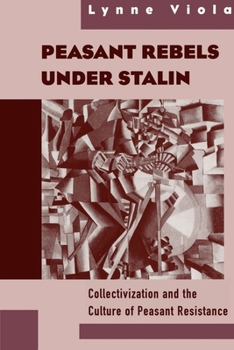Peasant Rebels Under Stalin: Collectivization and the Culture of Peasant Resistance
Select Format
Select Condition 
Book Overview
The first book to document the peasant rebellion against Soviet collectivization, Peasant Rebels Under Stalin retrieves a crucial lost chapter from the history of Stalinist Russia. The peasant revolt against collectivization, as reconstructed by author Lynne Viola, was the most violent and sustained resistance to the Soviet state after the Russian Civil War. Conservative estimates suggest that over the course of the 1020s and early 1930s, more than 1,100 people were assassinated, more than 13,000 villages rioted, and over 2.5 million people participated in this active struggle of resistance. This book is about the men and women who tried to preserve their families, communities, and beliefs from the depredations of Stalinism. Their acts were often heroic, but these heroes were homespun, ordinary people who were driven to acts of desperation by cruel and brutal state policies. This is a study of peasant community, culture, and politics through the prism of resistance. Based on newly declassified Soviet archives, including previously inaccessible OGPU (secret police) reports, Viola's work documents the manifestation in Stalin's Russia of universal strategies of peasant resistance in what amounted to a virtual civil war between state and peasantry. This book is must reading for scholars of Soviet history, Stalinism, popular resistance, and Russian peasant culture.
Format:Paperback
Language:English
ISBN:0195131045
ISBN13:9780195131048
Release Date:January 1999
Publisher:Oxford University Press
Length:328 Pages
Weight:1.16 lbs.
Dimensions:0.8" x 6.1" x 8.9"
Customer Reviews
1 rating
New Insights on Peasant Rebellion
Published by Thriftbooks.com User , 23 years ago
In an original new work of social history on the early Stalinist era, Lynne Viola examines an aspect of Soviet collectivization hitherto unconsidered, namely that of intense peasant resistance to the policy. Historians traditionally conceived of Stalin's policies in the countryside in purely totalitarian terms. These focused primarily or even entirely on an overbearing regime whose subjects were simply regarded as victims. Viola, in a superb example of historical revisionism, allows for the possibility of resistance by those once thought to have played little if any role during these years. In Viola's countryside the traditional victims of collectivization, the peasants of Ukraine, the Russian Volga, the Northern Caucasus, and other regions were just as influential in the events as those making and enforcing collectivization policies. Viola focuses on nearly all aspects of peasant revolt during the years of collectivization, from the seemingly irrational mass destruction of livestock to apocalyptic rumor mongering to the more everyday forms of rebellion like undermining Soviet grain collection efforts. Very few segments of rural society are left untreated, and perhaps the most thoroughly considered are women. Women were the agents of much peasant resistance precisely because Soviet authorities gave them more leeway due to their perceived political ignorance and naivete. In other words, those who are traditionally seen as the most vulnerable were in many ways among the most influential.For those wishing to strengthen their traditional conceptions of Stalinist society, Viola's landmark study will prove to be a serious disappointment, for it confirms very little of what was previously thought about the process of collectivization. Instead, her work challenges us with an entirely new vision. Viola meticulously utilizes an impressive collection of archival materials to fashion her arguments, and at the same time she remains open to the worthiest contributions in the fields of peasant, gender, and religious studies. Those interested in these fields as well as in Soviet history in general will gain an important perspective from one of the twentieth century's most important episodes. Viola, a leader among Western scholars of the early Soviet era, has made a most invaluable contribution to its literature.





